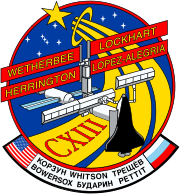 Lopez-Alegria climbs the newly-installed P1 truss during the mission's second EVA | |
| Names | Space Transportation System-113 |
|---|---|
| Mission type | ISS assembly Crew rotation |
| Operator | NASA |
| COSPAR ID | 2002-052A |
| SATCAT no. | 27556 |
| Mission duration | 13 days, 18 hours, 48 minutes, 38 seconds |
| Distance travelled | 9,000,000 kilometres (5,600,000 mi) |
| Spacecraft properties | |
| Spacecraft | Space Shuttle Endeavour |
| Launch mass | 116,460 kilograms (256,750 lb) |
| Landing mass | 91,498 kilograms (201,719 lb) |
| Payload mass | 12,477 kilograms (27,507 lb) |
| Crew | |
| Crew size | 7 |
| Members | |
| Launching | |
| Landing | |
| Start of mission | |
| Launch date | 24 November 2002, 00:49:47 UTC |
| Launch site | Kennedy, LC-39A |
| End of mission | |
| Landing date | 7 December 2002, 19:38:25 UTC |
| Landing site | Kennedy, SLF Runway 33 |
| Orbital parameters | |
| Reference system | Geocentric |
| Regime | Low Earth |
| Perigee altitude | 379 kilometres (235 mi) |
| Apogee altitude | 397 kilometres (247 mi) |
| Inclination | 51.6 degrees |
| Period | 92.3 min |
| Docking with ISS | |
| Docking port | PMA-2 (Destiny forward) |
| Docking date | 25 November 2002, 21:59 UTC |
| Undocking date | 2 December 2002, 20:50 UTC |
| Time docked | 6 days, 22 hours, 51 minutes |
  (L-R): Paul S. Lockhart, Michael E. López-Alegría, John B. Herrington, and James D. Wetherbee | |
STS-113 was a Space Shuttle mission to the International Space Station (ISS) flown by Space Shuttle Endeavour . During the 14-day mission in late 2002, Endeavour and its crew extended the ISS backbone with the P1 truss and exchanged the Expedition 5 and Expedition 6 crews aboard the station. With commander Jim Wetherbee and pilot Paul Lockhart at the controls, Endeavour docked with the station on 25 November 2002 to begin seven days of station assembly, spacewalks, and crew and equipment transfers. This was the last flight of Endeavour before entering its Orbiter Major Modification period until STS-118 in 2007, which included modernizing the cockpit, and also the final shuttle mission before the Columbia disaster.









